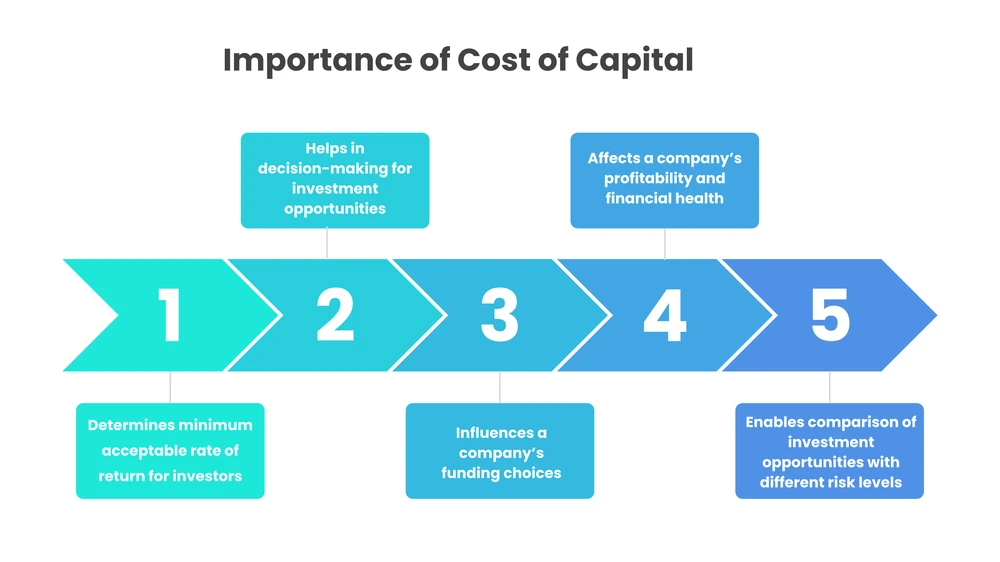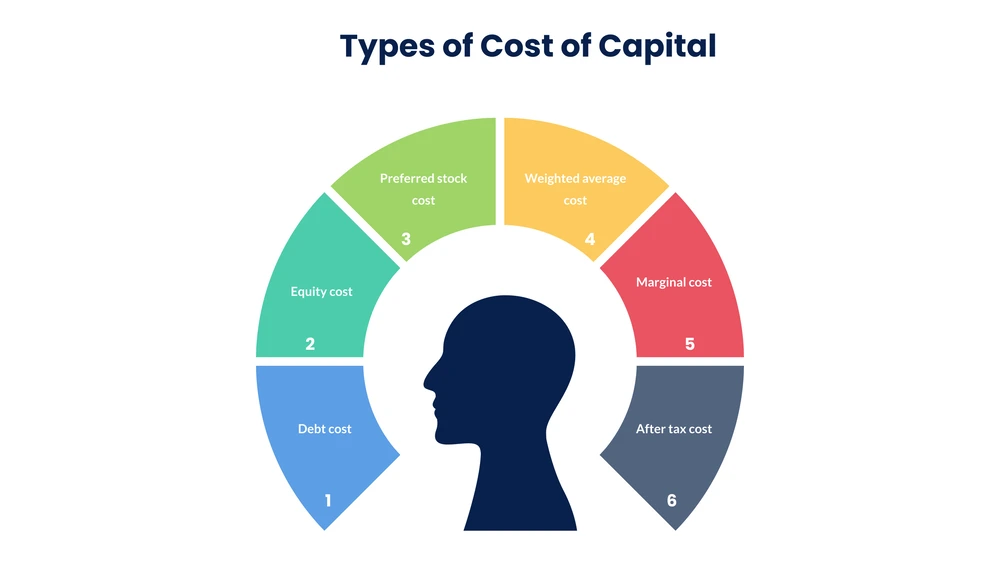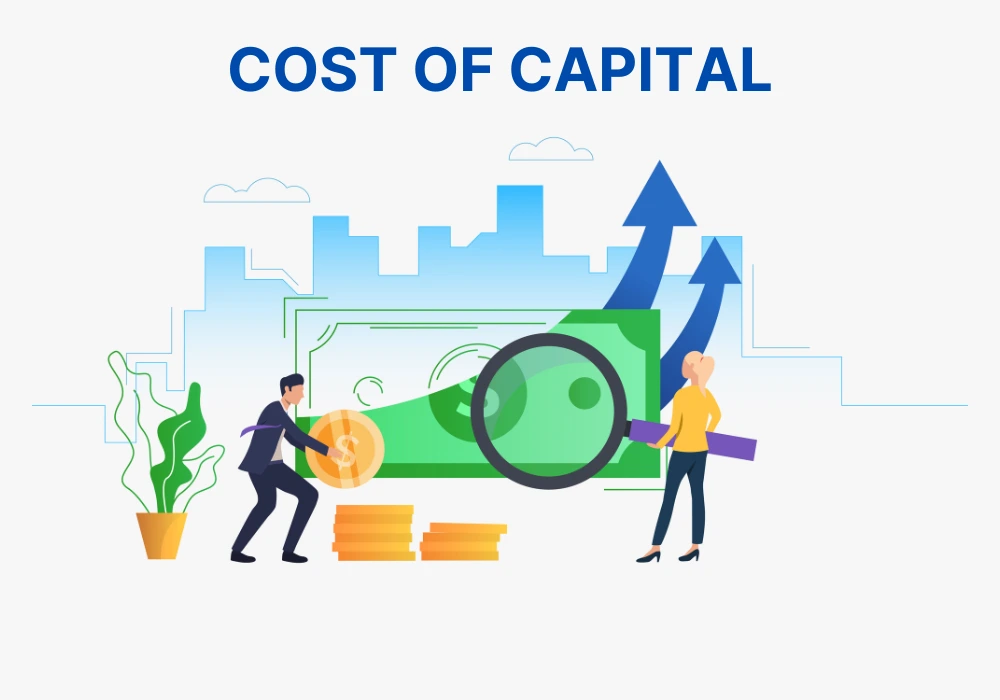The cost of capital is like the entrance fee to the financial playground.
What is cost of capital?
Cost of capital is the price a company incurs to borrow money or raise capital from investors to fund its operations or investments. This cost includes both the interest rate paid on debt and the return expected by investors for providing equity financing. Basically, it’s the price a company pays for the privilege of using other people’s money.
Quick Read: Capital Expenditure (CapEX): Meaning, Types, Examples & Formula
Understanding cost of capital
Cost of capital refers to the total financing amount a company incurs to raise funds from both debt and equity sources. It represents the minimum rate of return a company must achieve on its investments to satisfy the expectations of its investors and lenders. Calculating the price of capital involves assessing the risk associated with each funding source and determining the appropriate capital cost for each.
This information is essential for a company when deciding which projects to pursue, as it allows them to assess the potential profitability of each investment opportunity. By understanding the capital requirements, a company can make informed decisions about how to finance its operations and investments, and ensure that it is maximizing its financial returns.
Quick Read: Budgeting and Forecasting: A Comprehensive Guide
Importance of cost of capital for business
Cost of capital is like a compass that guides a company toward its financial goals. It’s important because it helps a company determine the minimum return it needs to generate from its investments to satisfy the expectations of its investors and lenders.
By calculating this cost, a company can also make informed decisions about which funding sources to use and which projects to pursue. Ultimately, understanding the price of capital can help a company maximize its profitability and avoid getting lost in the financial wilderness.

Types of cost of capital

- Debt Cost: the cost a company incurs when raising funds through debt, including interest payments and other fees.
- Equity: the return that investors expect to earn when investing in a company’s stock, taking into account dividends and capital gains.
- Preferred Stock Cost: the cost a company incurs when raising funds through preferred stock, which typically pays a fixed dividend.
- Weighted Average Cost (WACC): the average price of all of a company’s capital sources, taking into account the proportion of each type of funding used.
- Marginal Cost: the cost of raising additional funds beyond the current level of funding.
- After-Tax Cost: the cost of capital adjusted for the tax benefits of debt financing.
Methods of cost of capital
Here are some common methods:
- Dividend Discount Model (DDM): estimates the cost of equity by calculating the present value of expected future dividend payments.
- Capital Asset Pricing Model (CAPM): estimates the price of equity by considering the risk-free rate of return, the expected market return, and the company’s beta.
- Bond Yield Plus Risk Premium: estimates the cost of debt by adding a risk premium to the yield of comparable bonds.
- Weighted Average Cost of Capital (WACC): calculates the average price of all of a company’s capital sources, weighted by the proportion of each type of funding used.
- Marginal Cost: estimates the cost of raising additional funds beyond the current level of funding.
Quick Read: Working Capital: What is it, Types, Formula & How to calculate it?
How to calculate cost of capital?
First, you have to calculate the cost of equity using the following methods. Then, you need to calculate cost of debt. Only then you can calculate the final cost of capital.
- Dividend Discount Model (DDM)
This method estimates the cost of equity by calculating the present value of expected future dividend payments.
1.1 Formula
Cost of Equity = (Expected Annual Dividends / Current Stock Price) + Growth Rate of Dividends.
1.2 Variables
The variables used in DDM are expected annual dividends, current stock price, and growth rate of dividends.
1.3 Example
DDM is commonly used by investors to estimate the cost of equity for a publicly traded company.
1.4 Advantages
1. Easy to understand and use.
2. Useful for valuing stable, mature companies with predictable dividends.
1.5 Disadvantages
1. Relies on assumptions about future dividends.
2. Not suitable for companies that do not pay dividends. - Capital Asset Pricing Model (CAPM)
CAPM estimates the cost of equity by considering the risk-free rate of return, the expected market return, and the company’s beta.
2.1 Formula
Cost of Equity = Risk-free rate + Beta * (Expected Market Return – Risk-free rate).
2.2 Variables
The variables used in CAPM are risk-free rate, expected market return, and beta.
2.3 Example
CAPM is frequently used by financial analysts to evaluate the cost of equity for a company.
2.4 Advantages
1. Widely accepted and used in the financial industry.
2. Can be used to estimate the cost of equity for any company.
2.5 Disadvantages
1. Based on several assumptions, which may not hold true in practice.
2. May not accurately reflect the risk of a company’s stock. - Bond Yield Plus Risk Premium
This method estimates the cost of debt by adding a risk premium to the yield of comparable bonds.
3.1 Formula
Cost of Debt = Yield on Comparable Bonds + Risk Premium.
3.2 Variables
The variables used in this method are yield on comparable bonds and risk premium.
3.3 Example
Bond yield plus risk premium is used to estimate the cost of debt for a company.
3.4 Advantages
1. Relatively simple to use.
2. It can be used to estimate the cost of debt for any company.
3.5 Disadvantages
1. It may not accurately reflect a company’s credit risk.
2. Only applicable for debt financing.
Quick Read: Cash Flow Forecasting: Definition, Advantages, and How to Ace It - Weighted Average Cost of Capital (WACC)
WACC calculates the average price of all of a company’s capital sources, weighted by the proportion of each type of funding used.
4.1 Formula
WACC = (Weight of Debt * Cost of Debt) + (Weight of Equity * Cost of Equity) + (Weight of Preferred Stock * Cost of Preferred Stock).
4.2 Variables
The variables used in WACC are the weights of debt, equity, and preferred stock, and the respective costs of each.
4.3 Example
WACC is used by companies to evaluate the overall capital price for their business.
4.4 Advantages
1. Comprehensive, as it considers all types of capital.
2. Useful for evaluating investment projects and making capital budgeting decisions.
4.5 Disadvantages
1. It can be difficult to calculate and may require detailed financial data.
2. It may not account for changes in market conditions. - Marginal Cost of Capital
This method estimates the cost of raising additional funds beyond the current level of funding.
5.1 Formula
Marginal Cost of Capital = (Cost of New Equity * Weight of New Equity) + (Cost of New Debt * Weight of New Debt)
5.2 Variables
The variables used in this method are the cost of new equity, the weight of new equity, cost of new debt, and weight of new debt.
5.3 Example
Marginal price of capital is used to evaluate the price of raising additional funds for a specific project or investment.
5.4 Advantages
1. Useful for evaluating the cost of raising additional funds for a specific investment.
2. Considers the specific capital structure of a company.
5.5 Disadvantages
1. Only applicable for evaluating specific investments.
2. It may be affected by changes in a company’s capital structure.
Quick Read: Cash Flow Statements: A Comprehensive Guide
Factors that Affect Cost of Capital
1. Interest rates
The cost of borrowing is directly affected by interest rates, so changes in interest rates can impact the expense of funds. Higher interest rates generally result in a higher expense of funds.
2. Inflation
Inflation can also impact the expense of funds, as it affects the purchasing power of money. High inflation can lead to higher interest rates and a higher expense of funds.
3. Market conditions
The state of the financial markets can also impact the expense of funds. In a stable market, the expense of funds may be lower than in a volatile market.
4. Credit rating
A company’s credit rating can impact the expense of borrowing, as lenders may charge higher interest rates for riskier borrowers. A higher credit rating generally results in a lower expense of funds.
5. Financial leverage
Financial leverage refers to the use of debt financing. Companies with higher levels of debt generally have a higher expense of funds, as they are perceived as riskier by lenders.
6. Capital structure
The mix of debt and equity financing in a company’s capital structure can also impact the expense of funds. The cost of debt and equity financing are both taken into consideration when calculating the weighted average cost of funds (WACF). Companies with a higher proportion of equity financing may have a higher expense of funds.
Quick Read: 10 Best Financial Management Tools
Managing Cost of Capital
Managing capital price is critical for businesses to ensure that they are utilizing their resources in the most efficient way possible. It helps companies to maximize their returns while minimizing their expenses. By optimizing their capital structure, companies can reduce their price of capital and make their operations more profitable.
Effective capital management can also improve a company’s creditworthiness and increase its ability to raise capital in the future. Companies that have a good understanding of their capital and have optimized their capital structure are seen as more stable and reliable by investors and lenders. This can lead to better access to funding, lower borrowing costs, and improved financial performance in the long run.
You can manage the company’s capital price by using the following strategies.
- Capital structure optimization
- Risk management
- Diversification of funding sources
- Capital price benchmarking
By implementing these strategies, companies can effectively manage their capital expenditure and improve their financial performance.
Discussion of strategies for managing the cost of capital
1. Capital structure optimization
Capital structure optimization involves determining the ideal mix of debt and equity financing for a company to minimize the capital. This can be achieved by analyzing the company’s financial statements, assessing its risk profile, and considering external market conditions. By finding the optimal capital structure, a company can reduce its price and increase its overall profitability.
2. Risk management
Risk management is an essential part of managing the price of capital. By identifying and mitigating risks, a company can reduce the cost of debt and equity financing. This can be done by implementing effective risk management policies and procedures, such as diversifying the company’s operations and investments, maintaining adequate insurance coverage, and implementing proper internal controls.
3. Diversification of funding sources
Diversification of funding sources is another strategy for managing capital. By obtaining financing from a variety of sources, a company can reduce its reliance on any one source and minimize the impact of market fluctuations. This can include obtaining financing from banks, issuing bonds, or seeking equity financing from investors.
4. Cost of capital benchmarking
Cost of capital benchmarking involves comparing a company’s expenses to that of similar companies in the same industry. By benchmarking its cost, a company can identify areas for improvement and adjust its financing strategy accordingly. This can help a company maintain its competitiveness in the market and improve its overall financial performance.
What is a discount rate?
The discount rate is the interest rate a company uses to convert future cash flows into their present-day values. It helps businesses make better financial decisions by calculating the value of future cash flows in today’s terms. It’s a critical tool in financial analysis; without it, we’d all be lost in a sea of uncertainty.
Quick Read: 6 Best Cash Flow Management Software
Cost of capital vs discount rate
Cost of Capital |
Discount Rate |
|
The cost of capital is the rate of return that a company must pay to its investors in order to fund its operations. |
The discount rate is the rate at which future cash flows are discounted to their present value. |
|
It takes into account the cost of debt and equity financing. |
It takes into account the time value of money, inflation, and other risk factors. |
|
It’s used to evaluate investment opportunities and determine the feasibility of projects. |
It’s used to calculate the present value of future cash flows and make investment decisions. |
|
It’s influenced by various factors such as interest rates, inflation, and market conditions. |
It’s influenced by factors such as the expected rate of return, inflation, and the riskiness of the investment. |
|
It’s used to determine the minimum rate of return that a project must generate to be considered viable. |
It’s used to determine the maximum price that an investor should pay for an investment. |
|
It’s typically higher than the risk-free rate of return. |
It can be higher or lower than the cost of capital, depending on the riskiness of the investment. |
Conclusion
In conclusion, the cost of capital is a crucial financial concept that determines the minimum rate of return a company needs to earn to meet its financial obligations and satisfy its investors. The cost of capital is influenced by various factors such as interest rates, inflation, market conditions, credit ratings, and financial leverage.
By understanding the capital cost, companies can evaluate investment opportunities, determine the feasibility of projects, and optimize their capital structure to minimize their expenses.
FAQ’s
The cost of capital is the minimum rate of return that a company must earn on its investments to satisfy its investors and financial obligations.
The cost of capital is important because it helps companies evaluate investment opportunities, determine the feasibility of projects, and optimize their capital structure to minimize the cost of capital.
The formula for calculating the cost of capital depends on the method used. For example, the cost of equity capital can be calculated using the capital asset pricing model (CAPM) or the dividend discount model (DDM), while the cost of debt capital can be calculated using the bond yield plus risk premium method.
The weighted average cost of capital (WACC) is a calculation that takes into account the cost of equity and debt capital, as well as the proportion of each in a company’s capital structure.
The cost of equity capital is the return required by investors in exchange for their investment in a company’s stock.
The marginal cost of capital is the cost of raising an additional dollar of capital.
The implicit cost of capital refers to the opportunity cost of using company resources for a specific project or investment, rather than using those resources for an alternative project or investment.
The composite cost of capital is a calculation that takes into account the cost of equity and debt capital, as well as other sources of financing, such as preferred stock or convertible bonds.
Capital structure can affect the cost of capital because the mix of equity and debt financing in a company’s capital structure can impact the risk perception of investors and lenders.
The difference between cost of capital and WACC is that the cost of capital is the minimum rate of return required by investors for a specific source of capital, while WACC is a calculation that takes into account the cost of all sources of financing in a company’s capital structure.
The choice between WACC and CAPM depends on the specific needs of the company and the nature of the investment being evaluated.
The WACC is used to evaluate the feasibility of new investments, determine the minimum required rate of return for new projects, and make capital budgeting decisions.
The CAPM is used to calculate the expected return on an investment, based on the risk-free rate, market risk premium, and the asset’s beta. It is commonly used to determine the cost of equity capital.



Discussion about this post